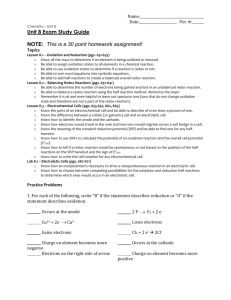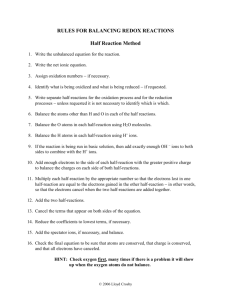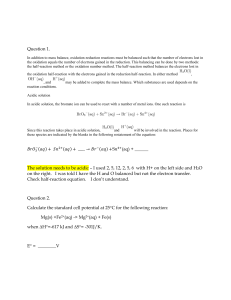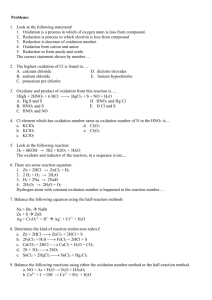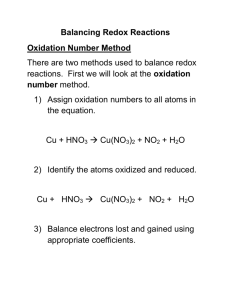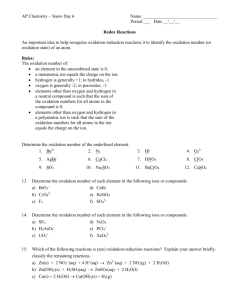Oxidation reduction 16 page guide
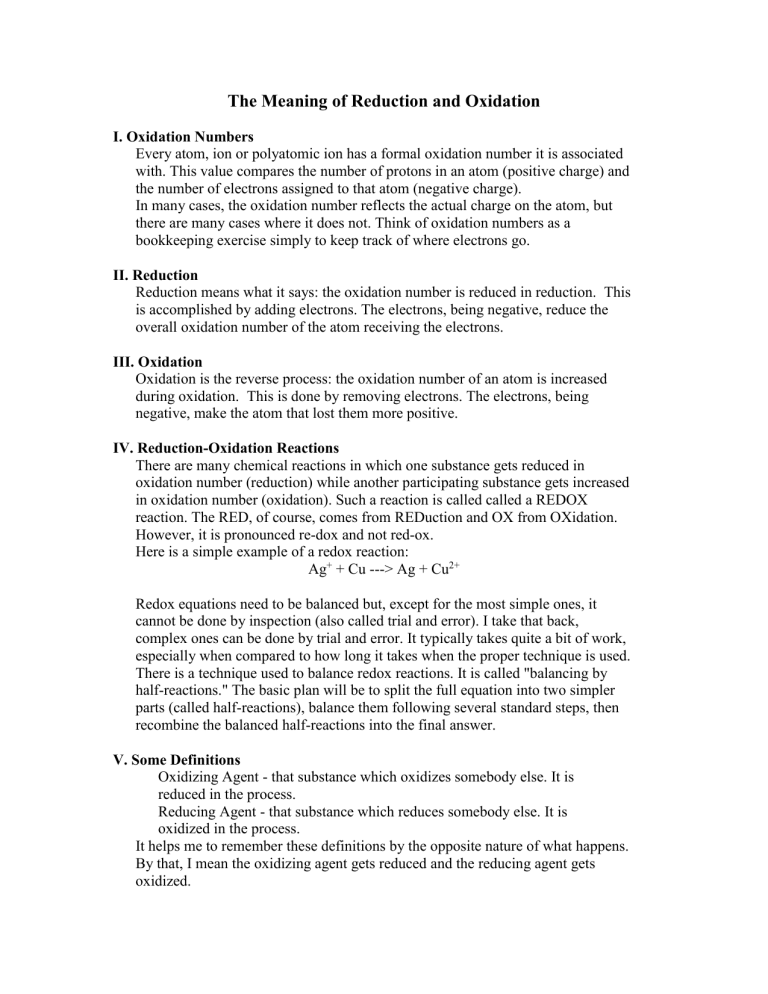
The Meaning of Reduction and Oxidation
I. Oxidation Numbers
Every atom, ion or polyatomic ion has a formal oxidation number it is associated with. This value compares the number of protons in an atom (positive charge) and the number of electrons assigned to that atom (negative charge).
In many cases, the oxidation number reflects the actual charge on the atom, but there are many cases where it does not. Think of oxidation numbers as a bookkeeping exercise simply to keep track of where electrons go.
II. Reduction
Reduction means what it says: the oxidation number is reduced in reduction. This is accomplished by adding electrons. The electrons, being negative, reduce the overall oxidation number of the atom receiving the electrons.
III. Oxidation
Oxidation is the reverse process: the oxidation number of an atom is increased during oxidation. This is done by removing electrons. The electrons, being negative, make the atom that lost them more positive.
IV. Reduction-Oxidation Reactions
There are many chemical reactions in which one substance gets reduced in oxidation number (reduction) while another participating substance gets increased in oxidation number (oxidation). Such a reaction is called called a REDOX reaction. The RED, of course, comes from REDuction and OX from OXidation.
However, it is pronounced re-dox and not red-ox.
Here is a simple example of a redox reaction:
Ag + + Cu ---> Ag + Cu 2+
Redox equations need to be balanced but, except for the most simple ones, it cannot be done by inspection (also called trial and error). I take that back, complex ones can be done by trial and error. It typically takes quite a bit of work, especially when compared to how long it takes when the proper technique is used.
There is a technique used to balance redox reactions. It is called "balancing by half-reactions." The basic plan will be to split the full equation into two simpler parts (called half-reactions), balance them following several standard steps, then recombine the balanced half-reactions into the final answer.
V. Some Definitions
Oxidizing Agent - that substance which oxidizes somebody else. It is reduced in the process.
Reducing Agent - that substance which reduces somebody else. It is oxidized in the process.
It helps me to remember these definitions by the opposite nature of what happens.
By that, I mean the oxidizing agent gets reduced and the reducing agent gets oxidized.
Rules for Assigning Oxidation Numbers
I. Rule Number One
All free, uncombined elements have an oxidation number of zero.
This includes diatomic elements such as O
2
or others like P
4
and S
8
.
II. Rule Number Two
Hydrogen, in all its compounds except hydrides, has an oxidation number of +1
(positive one)
III. Rule Number Three
Oxygen, in all its compounds except peroxides, has an oxidation number of -2
(negative two).
With only a very few exceptions, oxidation states can be assigned to all atoms in a formula. There are more extensive sets of rules and, for the most part, they derive from the three above rules.
There are some complex examples which are not discussed in the usual set of introductory rules. For example, potassium superoxide is KO
2
. That means that the oxidation number on the O
2
is negative one. These more complex examples will not be taught in this tutorial.
Now, some examples:
1. What is the oxidation number of Cl in HCl?
Since H = +1, the Cl must be -1 (minus one).
2. What is the oxidation number of Na in Na
2
O?
Since O = -2, the two Na must each be +1.
3. What is the oxidation number of Cl in ClO¯?
The O is -2, but since a -1 must be left over, then the Cl is +1.
4. What is the oxidation number for each element in KMnO
4
?
K = +1 because KCl exists. We know the Cl = -1 because HCl exists. O = -2 by definition Mn = +7. There are 4 oxygens for a total of -8, K is +1, so Mn must be the rest.
5. What is the oxidation number of S in SO
4
2 ¯
O = -2. There are four oxygens for -8 total. Since -2 must be left over, the S must
= +6.
Please note that, if there is no charge indicated on a formula, the total charge is taken to be zero.
Practice Problems (Set A)
What is the oxidation number of . . .
1) N in NO
3
¯
6) Pb in PbOH
+
2) C in CO
3
2 ¯
3) Cr in CrO
4
2 ¯
7) V in VO
2
+
8) V in VO
2+
4) Cr in Cr
2
O
7
2 ¯
5) Fe in Fe
2
O
3
9) Mn in MnO
4
¯
10) Mn in MnO
4
2 ¯
Rules for Assigning Oxidation Numbers
Practice Problem Answers
Answers
1) N in NO
3
¯
The O is -2 and three of them makes -6. Since -1 is left over, the N must be +5
2) C in CO
3
2 ¯
The O is -2 and three of them makes -6. Since -2 is left over, the C must be +4
3) Cr in CrO
4
2 ¯
The O is -2 and four of them makes -8. Since -2 is left over, the Cr must be +6
4) Cr in Cr
2
O
7
2 ¯
The O is -2 and seven of them makes -14. Since -2 is left over, the two Cr must be
+12
What follows is an important point. Each Cr is +6. Each one. We do not speak of
Cr
2
being +12. Each Cr atom is considered individually.
5) Fe in Fe
2
O
3
The O is -2 and three of them makes -6. Each Fe must then be +3
The answers for 6-10 are given below. If you are not sure how a value was determined, check with your teacher.
6) +2
7) +5
8) +4
9) +7
10) +6
What is a Half-Reaction?
A half-reaction is simply one which shows either reduction OR oxidation, but not both.
Here is the example redox reaction used before:
Ag
+
+ Cu ---> Ag + Cu
2+
It has BOTH a reduction and an oxidation in it. That is why we call it a redox reaction, from REDuction and OXidation.
What you must be able to do is look at a redox reaction and separate out the two halfreactions in it. To do that, identify the atoms which get reduced and get oxidized. Here are the two half-reactions from the above example:
Ag
+
---> Ag
Cu ---> Cu
2+
The silver is being reduced, its oxidation number going from +1 to zero. The copper's oxidation number went from zero to +2, so it was oxidized in the reaction. In order to figure out the half-reactions, you MUST be able to calculate the oxidation number of an atom.
Keep in mind that a half-reaction shows only one of the two behaviors we are studying. A single half-reaction will show ONLY reduction or ONLY oxidation, never both in the same equation.
Also, notice that the reaction is read from left to right to determine if it is reduction or oxidation. If you read the reaction in the opposite direction (from right to left) it then becomes the other of our two choices (reduction or oxidation). For example, the silver
half-reaction above is a reduction, but in the reverse direction it is an oxidation, going from zero on the right to +1 on the left.
There will be times when you want to switch a half-reaction from one of the two types to the other. In that case, rewrite the entire equation and swap sides for everything involved.
If I needed the silver half-reaction to be oxidation, I'd write Ag ---> Ag
+
rather tha just doing it mentally.
OK, back to the next step, which is both half-reactions must be balanced. However, there is a twist. When you learned about balancing equation, you made equal the number of atoms of each element on each side of the arrow. That still applies, but there is one more thing: the total amount of charge on each side of the half-reaction MUST be the same.
When you look at the two half-reactions above, you will see they are already balanced for atoms with one Ag on each side and one Cu on each side. So, all we need to do is balance the charge. To do this you add electrons to the more positive side. You add enough to make the total charge on each side become EQUAL.
To the silver half-reaction, we add one electron:
Ag + + e¯ ---> Ag
To the copper half-reaction, we add two electrons:
Cu ---> Cu
2+
+ 2e¯
One point of concern: notice that each half-reaction wound up with a total charge of zero on each side. This is not always the case. You need to strive to get the total charge on each side EQUAL, not zero.
One more point to make before wrapping this up. A half-reaction is a "fake" chemical reaction. It's just a bookkeeping exercise. Half-reactions NEVER occur alone. If a reduction half-reaction is actually happening (say in a beaker in front of you), then an oxidation reaction is also occurring. The two half-reactions can be in separate containers, but they do have to have some type of "chemical connection" between them. The nature of this connection is the subject of another tutorial.
Half-Reactions Practice Problems (Set B)
Balance each half-reaction for atoms and charge:
1) Cl
2
---> Cl¯
2) Sn ---> Sn
2+
3) Fe 2+ ---> Fe 3+
4) I
3
¯ ---> I¯
5) ICl
2
¯ ---> I¯
Separate each of these redox reactions into their two half-reactions (but do not balance):
6) Sn + NO
3
¯ ---> SnO
2
+ NO
2
7) HClO + Co ---> Cl
2
+ Co
2+
8) NO
2
---> NO
3
¯ + NO
Half-Reactions Practice Problems
Answers
1) Cl
2
+ 2e¯ ---> 2Cl¯
2) Sn ---> Sn
2+
+ 2e¯
3) Fe
2+
---> Fe
3+
+ e¯
4) I
3
¯ + 2e¯ ---> 3I¯
5) ICl
2
¯ + 2e¯ ---> I¯ + 2Cl¯
6) Sn ---> SnO
2
and NO
3
¯ ---> NO
2
7) HClO ---> Cl
2
and Co ---> Co
2+
8) NO
2
---> NO
3
¯ and NO
2
---> NO
Balancing Half-Reactions in Acid Solution
Reminder: a half-reaction MUST be balanced both for atoms and charge in order to be correct. It is VERY easy to balance for atoms only, forgetting to check the charge.
DON'T FORGET.
Here is the half-reaction to be considered:
MnO
4
¯ ---> Mn 2+
It is to be balanced in acid solution.
Here is a second half-reaction, also in acid solution:
Cr
2
O
7
2 ¯ ---> Cr 3+
Before looking at the balancing technique, the fact that it is in acid solution can be signaled to you in several different ways:
1) It is explicitly said in the problem.
2) An acid (usually a strong acid) is included as one of the reactants.
3) An H + is written just above the reaction arrow.
Someday you will be able to tell the solution is acidic by knowing the characteristic products of various reactants. For example, in the above reaction, the permanganate ion is reduced to the Mn
2+
. This is characteristic behavior in acid solution. In basic solution a different product is formed from permanganate.
Here's the last point before teaching the technique. There are three other chemical species available in an acidic solution besides the ones shown above. They are:
H
2
O
H + e¯
The water is present because the reaction is taking place in solution, the hydrogen ion is available because it is in acid solution and electrons are available because that's what is transferred in redox reactions. All three will be used in getting the final answer.
Step One: Balance the atom being reduced/oxidized.
In our example, there is already one Mn on each side of the arrow, so this step is already done. (Hint: not so for the dichromate example you are working in parallel.)
MnO
4
¯ ---> Mn 2+
Step Two: Balance the oxygens.
Do this by adding water molecules (as many as are needed) to the side needing oxygen. In our case, the left side has 4 oxygens, while the right side has none, so:
MnO
4
¯ ---> Mn 2+
+ 4H
2
O
Notice that, when the water is added, hydrogens also come along. There is nothing that can be done about this; we'll take care of it in the next step. A common question is: "Why can't I just add 4 oxygen atoms to the right side?" Quick answer: don't do it, it's wrong.
The "why" will be left to another day.
Step Three: Balance the hydrogens.
Do this by adding hydrogen ions (as many as are needed) to the side needing hydrogen. In our example, we need 8 (notice the water molecule's formula, then consider 4 x 2 = 8).
8H
+
+ MnO
4
¯ ---> Mn 2+
+ 4H
2
O
Step Four: Balance the total charge.
This will be done using electrons. It is ALWAYS the last step.
First, a comment. You do not need to look at the oxidation number for each atom. You only need to look at the charge on the ion or molecule, then sum those up.
Left side of the reaction, total charge is +7. There are 8 H + , giving 8 x +1 = +8 and a minus one from the permanganate. (A very typical wrong answer for the left side is zero.
The person sees only the +1 and the -1, they forget the 8. When you do this step in the parallel example, don't forget to multiply 2 times 3. I'll leave you to figure out where in the problem that is.)
Right side of the reaction, total charge is +2. The water molecule is neutral (zero charge) and the single Mn is +2.
5e¯ + 8H + + MnO
4
¯ ---> Mn 2+ + 4H
2
O
Five electrons reduces the +7 to a +2 and the two sides are EQUAL in total charge. The half-reaction is now correctly balanced.
Another example (in acid solution).
SO
2
---> SO
4
2 ¯
By the way, a tip off that this is acid solution is the SO
2
. Oxides of nonmetals make acidic solutions (and oxides of metals make basic solutions). Here are the steps:
1) SO
2
---> SO
4
2 ¯ (the sulfur is already balanced)
2) 2H
2
O + SO
2
---> SO
4
2 ¯ (now there are 4 oxygens on each side)
3) 2H
2
O + SO
2
---> SO
4
2
4) 2H
2
O + SO
2
---> SO
4
2
¯ + 4H + (2 x 2 from the water makes 4 hydrogens)
¯ + 4H +
+ 2e¯ (zero charge on the left; +4 from the hydrogens and -2 from the sulfate, so 2 electrons gives the -2 charge required to make zero on the right)
Practice Problems (Set C)
Balance each half-reaction, the reaction being in acidic solution.
1) Re ---> ReO
2
2) Cl
2
---> HClO
3) NO
3
¯ ---> HNO
2
4) H
2
GeO
3
---> Ge
5) H
2
SeO
3
---> SeO
4
2 ¯
6) Au ---> Au(OH)
3
7) H
3
AsO
4
---> AsH
3
8) H
2
MoO
4
---> Mo
9) NO ---> NO
3
¯
Practice Problem Answers
Acid Solution
Answers
1) Re ---> ReO
2
Step One: Balance the atom being reduced/oxidized: Re ---> ReO
2
Step Two: Balance the oxygens: 2H
2
O + Re ---> ReO
2
Step Three: Balance the hydrogens: 2H
2
O + Re ---> ReO
2
+ 4H
+
Step Four: Balance the total charge: 2H
2
O + Re ---> ReO
2
+ 4H + + 4e¯
2) Cl
2
---> HClO
1) Cl
2
---> 2HClO (chlorine is balanced)
2) 2H
2
O + Cl
2
---> 2HClO (now there are 2 oxygens on each side)
3) 2H
2
O + Cl
2
---> 2HClO + 2H
+
(2H in HClO plus 2H
+
makes 4 hydrogens)
4) 2H
2
O + Cl
2
---> 2HClO + 2H
+
+ 2e¯ (zero charge on the left; +2 from the hydrogen ions so 2 electrons gives the -2 charge required to make zero on the right)
3) NO
3
¯ ---> HNO
2
2e¯ + 3H +
+ NO
3
¯ ---> HNO
2
+ H
2
O
4) H
2
GeO
3
---> Ge
4e¯ + 4H +
+ H
2
GeO
3
---> Ge + 3H
2
O
5) H
2
SeO
3
---> SeO
4
2 ¯
H
2
O + H
2
SeO
3
---> SeO
4
2 ¯ + 4H + + 2e¯
6) Au ---> Au(OH)
3
3H
2
O + Au ---> Au(OH)
3
+ 3H
+
+ 3e¯
7) H
3
AsO
4
---> AsH
3
8e¯ + 8H +
+ H
3
AsO
4
---> AsH
3
+ 4H
2
O
8) H
2
MoO
4
---> Mo
6e¯ + 6H +
+ H
2
MoO
4
---> Mo + 4H
2
O
9) NO ---> NO
3
¯
2H
2
O + NO ---> NO
3
¯ + 4H +
+ 3e¯
Balancing Half-Reactions in Basic Solution
Reminder: a half-reaction MUST be balanced both for atoms and charge in order to be correct. It is VERY easy to balance for atoms only, forgetting to check the charge.
DON'T FORGET.
Here is the half-reaction to be considered:
PbO
2
---> PbO
It is to be balanced in basic solution.
Here is a second half-reaction, also in basic solution:
MnO
4
¯ ---> MnO
2
As I go through the steps below, try and balance this one as well. The answer will appear at the end of the file. Before looking at the balancing technique, the fact that it is in basic solution can be signaled to you in several different ways:
1) It is explicitly said in the problem.
2) A base (usually a strong base) is included as one of the reactants.
3) An OH¯ is written just above the reaction arrow.
Here's the last point before teaching the technique. There are three other chemical species available in a basic solution besides the ones shown above. They are:
H
2
O
OH¯ e¯
The water is present because the reaction is taking place in solution, the hydroxide ion is available because it is in basic solution and electrons are available because that's what is transfered in redox reactions. All three will be used in getting the final answer.
Step One to Four: Balance the half-reaction AS IF it were in acid solution.
I hope you got that. The half-reaction is actually in basic solution, but we are going to start out as if it were in acid solution. Here are the 4 acid steps:
1) Balance the atom being reduced/oxidized.
2) Balance the oxygens.
3) Balance the hydrogens.
4) Balance the charge.
When you do that to the above half-reaction, you get:
2e¯ + 2H +
+ PbO
2
---> PbO + H
2
O
Step Five: Convert all H + to H
2
O.
Do this by adding OH¯ ions to both sides. The side with the H
+
will determine how many hydroxide to add. In our case, the left side has 2 hydrogen ions, while the right side has none, so:
2e¯ + 2H
2
O + PbO
2
---> PbO + H
2
O + 2OH¯
Notice that, when the two hydroxide ions on the left were added, they immediately reacted with the hydrogen ion present. The reaction is:
H
+
+ OH¯ ---> H
2
O
Step Six: Remove any duplicate molecules or ions.
In our example, there are two water molecules on the left and one on the right. This means one water molecule may be removed from each side, giving:
2e¯ + H
2
O + PbO
2
---> PbO + 2OH¯
The half-reaction is now correctly balanced.
By the way, notice the 2OH¯. Be careful to read that as two hydroxide ions (2 OH¯) and
NOT twenty hydride ions (2O H¯). People have been known to do that.
Another example:
NH
3
---> N
2
H
4
Here are the steps:
1) 2NH
3
---> N
2
H
4
+ 2H
+
+ 2e¯ (balanced as if in acid solution; there were no oxygens to balance.)
2) 2OH¯ + 2NH
3
---> N
2
H
4
+ 2H
2
O + 2e¯ (add two hydroxides to each side; this is the correct answer, there are no duplicates to strike out.)
Practice Problems (Set D)
Balance each half-reaction, the reaction being in basic solution.
1) NiO
2
---> Ni(OH)
2
2) BrO
4
¯ ---> Br¯
3) SbO
3
¯ ---> SbO
2
¯
4) Cu
2
O ---> Cu
5) S
2
O
3
2 ¯ ---> SO
3
2 ¯
6) Tl
+
---> Tl
2
O
3
7) Al ---> AlO
2
¯
8) Sn ---> HSnO
2
¯
9) CrO
4
2 ¯ ---> Cr(OH)
3
Practice Problem Answers
Base Solution
1) NiO
2
---> Ni(OH)
2
Step One: Balance the half-reaction AS IF it were in acid solution: 2e¯ + 2H
+
+
NiO
2
---> Ni(OH)
2
Step Two: Convert all H + to H
2
O: 2e¯ + 2H
2
O + NiO
2
---> Ni(OH)
2
+ 2OH¯
Step Three: Remove any duplicate molecules or ions: none to be removed in this example. Other problems below will have duplicates.
2) BrO
4
¯ ---> Br¯
Step One: Balance the half-reaction AS IF it were in acid solution: 8e¯ + 8H
+
+
BrO
4
¯ ---> Br¯ + 4H
2
O
Step Two: Convert all H
+
to H
2
O: 8e¯ + 8H
2
O + BrO
4
¯ ---> Br¯ + 4H
2
O + 8OH¯
Step Three: Remove any duplicate molecules or ions: 8e¯ + 4H
2
Br¯ + 8OH¯
O + BrO
4
¯ --->
3) SbO
3
¯ ---> SbO
2
¯
2e¯ + H
2
O + SbO
3
¯ ---> SbO
2
¯ + 2OH¯
4) Cu
2
O ---> Cu
5) S
2e¯ + H
2
O
3
2
2
O + Cu
2
O ---> 2Cu + 2OH¯
¯ ---> SO
3
2 ¯
Step One: 3H
2
O + S
2
O
3
2 ¯ ---> 2SO
3
2 ¯ + 6H +
+ 4e¯ (note the 2 in front of the
SO
3
2 ¯)
Step Two: 6OH¯ + 3H
2
O + S
2
O
3
Step Three: 6OH¯ + S
2
O
3
2
2 ¯ ---> 2SO
3
2
¯ ---> 2SO
3
¯ + 6H
2
O + 4e¯
2 ¯ + 3H
2
O + 4e¯
6) Tl
+
---> Tl
2
O
3
6OH¯ + 2Tl +
---> Tl
2
O
3
+ 3H
2
O + 4e¯
7) Al ---> AlO
2
¯
4OH¯ + Al ---> AlO
2
¯ + 2H
2
O + 3e¯
8) Sn ---> HSnO
2
¯
3OH¯ + Sn ---> HSnO
2
¯ + H
2
9) CrO
4
2 ¯ ---> Cr(OH)
3
O + 2e¯
3e¯ + 4H
2
O + CrO
4
2 ¯ ---> Cr(OH)
3
+ 5OH¯
Balancing Redox Reactions in Acidic Solution
1) ClO
3
¯ + SO
2
---> SO
4
2 ¯ + Cl¯
2) H
2
S + NO
3
¯ ---> S
8
+ NO
3) MnO
4
¯ + H
2
S ---> Mn
2+
+ S
8
4) Cu + SO
4
2 ¯ ---> Cu 2+
+ SO
2
5) MnO
4
¯ + CH
3
OH ---> CH
3
COOH + Mn 2+
6) Cr
2
O
7
2 ¯ + Fe 2+
---> Cr
3+
+ Fe
3+
7) HNO
2
---> NO + NO
2
8) H
2
C
2
O
4
+ MnO
4
¯ ---> CO
2
+ Mn
2+
9) O
2
+ As ---> HAsO
2
+ H
2
O
10) NO
2
---> NO
3
¯ + NO
11) ClO
4
¯ + Cl¯ ---> ClO¯ + Cl
2
12) H
5
IO
6
+ Cr ---> IO
3
¯ + Cr 3+
13) Fe + HCl ---> HFeCl
4
+ H
2
14) NO
3
¯ + H
2
O
2
---> NO + O
2
15) BrO
3
¯ + Fe 2+ ---> Br¯ + Fe 3+
16) Cr
2
O
7
2 ¯ + C
2
H
4
O ---> CH
3
COOH + Cr
3+
17) MnO
4
¯ + C
2
H
4
O ---> CH
3
COOH + MnO
2
18) Zn + NO
3
¯ ---> NH
4
+
+ Zn
2+
19) HBr + SO
4
2 ¯ ---> SO
2
+ Br
2
20) NO
3
¯ + I
2
---> IO
3
¯ + NO
2
21) CuS + NO
3
¯ ---> NO + Cu 2+
+ HSO
4
¯
Balancing Redox Reactions in Acidic Solution
1) the two half-reactions:
6e¯ + 6H +
+ ClO
3
¯
--->
Cl¯ + 3H
2
O
2H
2
O + SO
2
---> SO
4
2 ¯ + 4H +
+ 2e¯
6e¯ + 6H +
+ ClO
3
¯ make the number of electrons equal:
--->
Cl¯ + 3H
2
O
3 [2H
2
O + SO
2
---> SO
4
2 ¯ + 4H +
+ 2e¯]
ClO
3
¯ + 3H
2
O + 3SO
2 the final answer:
---> 3SO
4
2 ¯ + Cl¯ + 6H +
2) the two half-reactions:
8H
2
S ---> S
8
+ 16H + + 16e¯
3e¯ + 4H + + NO
3
¯ ---> NO + 2H
2
O make the number of electrons equal:
3 [8H
2
S ---> S
8
+ 16H
+
+ 16e¯]
16 [3e¯ + 4H +
+ NO
3
¯
---> NO + 2H
2
O]
24H
2
S + 16H + + 16NO
3
¯ the final answer:
---> 3S
8
+ 16NO + 32H
2
O
Comment: removing a factor of 8 does look tempting, doesn't it? However, the three in front of the S
8
(or the five in the next problem) makes it impossible. Oh well.
3)
8H
2
S ---> S
8
+ 16H
+
+ 16e¯
5e¯ + 8H +
+ MnO
4
¯
---> Mn
2+
+ 4H
2
O make the number of electrons equal:
5 [8H
2
S ---> S
8
+ 16H
+
+ 16e¯]
---> Mn
2+
+ 4H
2
O]
16 [5e¯ + 8H +
+ MnO
4
¯
40H
2
S + 48H
+
+ 16MnO
4
¯ ---> the final answer:
4)
5S
Cu ---> Cu 2+ + 2e¯
8
+ 16Mn
2+
+ 64H
2
O
2e¯ + 4H + + SO
4
2 ¯ ---> SO
2
+ 2H
2
O
the final answer:
Cu + 4H
+
+ SO
4
2 ¯ --->
Cu
2+
+ SO
2
+ 2H
2
O
5)
2 [5e¯ + 4H +
+ MnO
4
¯ ---> Mn 2+
+ 4H
2
O]
5 [H
2
O + CH
3
OH ---> CH
3
COOH + 2H
+
+ 2e¯] the final answer:
6H
+
+ 2MnO
4
¯ + 5CH
3
OH ---> 2Mn
2+
+ 3H
2
O + 5CH
3
COOH
6)
6e¯ + 14H + + Cr
2
O
7
2 ¯ ---> 2Cr 3+ + 7H
2
O
6 [Fe
2+
---> Fe
3+
+ e¯] the final answer:
14H
+
+ Cr
2
O
7
2 ¯ + 6Fe 2+
---> 2Cr
3+
+ 7H
2
O + 6Fe
3+
7) e¯ + H +
+ HNO
2
---> NO + H
2
O
HNO
2
---> NO
2
+ H + + e¯ the final answer:
2HNO
2
---> NO + NO
2
+ H
2
O
Comment #1: notice that this is no H + in the final answer, but please keep in mind that its presence is necessary for the reaction to proceed. In cases like this, the H
+
is acting in a catalytic manner; it is used up in one reaction and regenerated in another (in equal amount), consequently it does not appear in the final answer.
Comment #2: this type of a reaction is called a disproportionation. It is often found in redox situations, although not always. An important disproportionation reaction which does not involve redox is 2H
2
O ---> H
3
O
+
+ OH¯. This reaction is of central importance in aqueous acid-base chemistry.
8)
5 [H
2
C
2
O
4
---> 2CO
2
+ 2H
+
+ 2e¯]
2 [5e¯ + 8H +
+ MnO
4
¯ ---> Mn 2+
+ 4H
2
O] the final answer:
5H
2
C
2
O
4
+ 6H
+
+ 2MnO
4
¯ ---> 10CO
2
+ 2Mn
2+
+ 8H
2
O
9) First a bit of discussion before the correct answer. The H
2
O on the right side in the problem turns out to be a hint. This is because you need TWO half-reactions. For example, suppose the water wasn't in the equation and you saw this:
O
2
+ As ---> HAsO
2
You'd think "Oh, that's easy" and procede to balance it like this:
H
+
+ O
2
+ As ---> HAsO
2
Then, you'd balance the charge like this: e¯ + H +
+ O
2
+ As ---> HAsO
2
And that is wrong because there is an electron in the final answer. You cannot have electrons appear in the final answer of a redox reaction. (You can in a half-reaction, but remember half-reactions do not occur alone, they occur in reduction-oxidation pairs.)
Here are the correct half-reactions:
3 [4e¯ + 4H +
+ O
2
---> 2H
2
O]
4 [2H
2
O + As ---> HAsO
2
+ 3H
+
+ 3e¯] the final answer:
3O
2
+ 2H
2
O + 4As ---> 4HAsO
2
Notice that the H
2
O on the right-hand side of the equation in the list of problems goes away.
By the way, try to balance
O
2
+ As ---> HAsO
2 using H
2
O on the left rather than H
+
. That way leads to the correct answer without having to use half-reactions. There are some redox reactions where using half-reactions turns out to be "more" work, but there aren't that many.
10)
H
2
O + NO
2
---> NO
3
¯ + 2H +
+ e¯
2e¯ + 2H +
+ NO
2
---> NO + H
+
The rest of the solution to No. 10 is left to the reader.
Balancing Redox Reactions in Basic Solution
1) NH
3
+ ClO¯ ---> N
2
H
4
+ Cl¯
2) Au + O
2
+ CN¯ ---> Au(CN)
2
¯ + H
2
O
2
3) Br¯ + MnO
4
¯ ---> MnO
2
+ BrO
3
¯
4) AlH
4
¯ + H
2
CO ---> Al
3+
+ CH
3
OH
5) Se + Cr(OH)
3
---> Cr + SeO
3
2 ¯
6) H
2
O
2
+ Cl
2
O
7
---> ClO
2
¯ + O
2
7) Fe + NiO
2
---> Fe(OH)
2
+ Ni(OH)
2
8) MnO
4
¯ + H
2
O
2
---> MnO
2
+ O
2
9) Zn + BrO
4
¯ ---> [Zn(OH)
4
]
2 ¯ + Br¯
10) MnO
4
¯ + S 2 ¯ ---> MnO
2
+ S
8
11) Pb(OH)
4
2 ¯ + ClO¯ ---> PbO
2
+ Cl¯
12) Tl
2
O
3
+ NH
2
OH ---> TlOH + N
2
13) Fe(OH)
2
+ CrO
4
2 ¯ ---> Fe
2
O
3
+ Cr(OH)
4
¯
14) Br
2
---> Br¯ + BrO
3
¯
15) ClO
2
¯ + H
2
O ---> ClO
2
¯ + OH¯
Balancing Redox Equations when there are Three Equations Involved
Before starting the sample equation, be assured that at least one equation will be a reduction and at least one equation will be an oxidation.
Here is the sample equation, in acidic solution:
FeS + NO
3
¯ ---> NO + SO
4
2 ¯ + Fe 3+
Step One: separate out the half-reactions. The only issue is that there are three of them.
Fe 2+ ---> Fe 3+
S 2 ¯ ---> SO
4
NO
3
¯
---> NO
2 ¯
How do you recognize there are three equations? The basic answer is "by experience."
The detailed answer is knowing the oxidation states of all the elements on EACH side of the original equation. By knowing this, one is able to determine that there were two oxidations (the Fe going +2 to +3 and the S going -2 to +6) with one reduction (the N going +5 to +2).
Notice you can split the FeS apart rather than write one equation (with FeS on the left side). This is done for simplicity, showing the three equations. Split the FeS apart because it has two "things" happening to it, in this case it is two oxidations.
Normally, FeS does not ionize, but you can get away with it here because it will recombine the Fe 2+ with the S 2 get a one-to-one ratio of Fe
2+
¯ in the final answer. If everything is done right, you will
to S
2 ¯.
Step Two: balancing all half-reactions in the normal manner.
Fe
2+
---> Fe
3+
+ e¯
4H
2
O + S
2 ¯ --->
SO
4
2 ¯ + 8H +
+ 8e¯
3e¯ + 4H +
+ NO
3
¯
---> NO + 2H
2
O
Step Three: equalize the electrons on each side of the half-reactions. Please note that the first two half-reactions (both oxidations) total up to nine electrons. Consequently, a factor of three is needed for the third equation, the only one shown below:
3 [3e¯ + 4H +
+ NO
3
¯
---> NO + 2H
2
O]
With the FeS put back together, the sum of all the coefficients (including any that are one) in the correct answer is 15.
